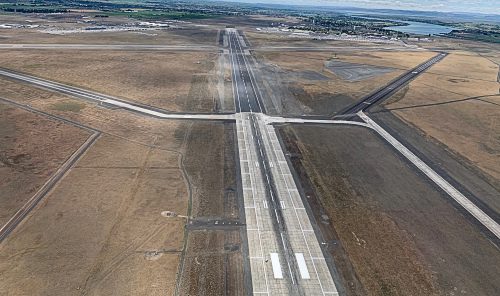Airports throughout the world face many of the same challenges, but Grant County International (MWH) in Moses Lake, WA, recently tackled an unusual airfield issue. It leveled a gradual, but pronounced, hump in the middle of its main runway.
Airports throughout the world face many of the same challenges, but Grant County International (MWH) in Moses Lake, WA, recently tackled an unusual airfield issue.
 It leveled a gradual, but pronounced, hump in the middle of its main runway. The sloping pavement, which spanned 4,400 linear feet and was about 5 feet tall at the highest point, made it impossible for some pilots to see traffic at the opposite end of the 13,500-foot runway. For safety, MWH had to shut down Runway 14L-32R at night when the control tower closed, due to FAA requirements.
It leveled a gradual, but pronounced, hump in the middle of its main runway. The sloping pavement, which spanned 4,400 linear feet and was about 5 feet tall at the highest point, made it impossible for some pilots to see traffic at the opposite end of the 13,500-foot runway. For safety, MWH had to shut down Runway 14L-32R at night when the control tower closed, due to FAA requirements.
“This was not a new problem for us,” states Airport Director Rich Mueller. “It goes back nearly 80 years.”
The unusual pavement profile dated back to World War II, when the U.S. Army Air Corps built the runway for training B-17 crews. Mueller explains that the hump was not an issue for the Army, because it was more critical to have a working runway than a level one. However, the hump did become problematic for MWH. While the runway serves a wider variety of military and civilian aircraft, it did not meet current FAA safety standards.
|
Project: Partial Runway Reconstruction Location: Grant County (WA) Int’l Airport Annual Operations: 83,000 Project Cost: About $20 million Funding: 90% FAA, 10% airport Key Objective: Remove 5-foot-tall hump in pavement to fix line-of-sight problem Concurrent Project: New LED edge lights & signage Construction Duration: 8 months (Nov. 2019 to June 2020)
Associated Runway Closure: 8 months (partial in Nov.-Dec.; full closure from Lead Design & Engineering Firm: Century West Engineering Key Subconsultant: Western Pacific Engineering Lead Contractor: Granite Construction Electrical Subcontractor: Neppel Electric & Controls Electrical Supplier: AirSide Solutions Lighting Manufacturer: ADB SAFEGATE Unforeseen Challenge: Continuing work despite COVID-19 crisis Key Benefit: Removing visual impediment enhances airfield safety, allows 24/7 runway operations Ancillary Advantages: New LED lighting improves visibility, lowers energy consumption, reduces maintenance |
With five runways, uncluttered airspace, consistently good weather and ample aprons, the central Washington airport attracts everything from the Boeing 737 MAX Return to Service program to fledgling pilots and aircraft mechanics from the local Big Bend Community College. It also is the site of international military exercises, air cargo shipments, widebody executive interior makeovers and certification of electric aircraft such as the Aviation Alice. Stretching 13,500 feet, Runway 14L-32R has enough length to handle any aircraft in the world.
The U.S. Air Force and U.S. Navy both regularly use the airfield for military training. The U.S. Forest Service bases VLAT (very large airtankers) there. Notable private sector activity includes a 747-400 reconfigured for testing Rolls-Royce engines. Test flights for new Boeing aircraft, including the latest 777X, are also performed at MWH. During summer, the airfield is especially busy due to an influx of large cargo planes that fly locally grown cherries to Asia.
With approximately 83,000 annual operations and a mix of traffic, the airport clearly needed to resolve the line-of-sight issue on its main runway. Fortunately, FAA officials gave MWH several years to make that happen.
In 2013, the airport updated its master plan, and removing the hump was a major component. The FAA agreed to cover 90% of the cost if MWH could meet various funding requirements. After the master plan was refreshed, the airport hired Century West in 2016 and underwent two years of preliminary project planning, with final design and engineering completed in early 2019.
Preliminary Phases
As lead consultant for the project, Century West executed planning, environmental statements, engineering, final design and construction. “We were selected for a five-year on-call arrangement to provide all services covering anything at the airport,” says Senior Program Manager Kurt Addicott. “However, the runway hump issue was one of our main responsibilities right away.”
Establishing a budget for the project proved to be a challenge that required multiple discussions between the FAA and the Port of Moses Lake, which owns the airport. Century West suspected that the FAA’s original $16 million budget (based on earlier planning level estimates from the Port) was not nearly enough money to cover the scope of the project. Given the airport’s goals, Century West performed a preliminary engineering analysis, and estimated costs at closer to $30 million.
In 2016 and 2017, Century West performed predesign work, including site condition assessments, surveys, geotechnical investigations, preliminary engineering analysis, concept level design, operational impacts and mitigation analysis, project phasing analysis, cost estimate and budget planning, initial environment/permitting coordination, and extensive FAA and stakeholder coordination. By the end of 2018, the team finalized environmental statements for the project, clearing the last major hurdle of FAA requirements. A $26 million grant was approved in early 2019, which meant that the airport had to come up with at least $2.6 million—its 10% obligation.

With a firm budget in hand, and the final grant approval issued, work amped up considerably for the project team. “Once everything was approved, we were on a tight timetable,” Addicott recalls. “We had to prepare the final design in four months to meet the established bid opening deadline.”
Concurrently, Century West held a series of workshops at the airport in late March and early April 2019 to inform potential contractors about the project. Addicott notes that the workshops were helpful to both the engineering consultant and contractors potentially interested in bidding for subsequent work.
The team issued a request for bids in May 2019, and asked for submissions by June 1, 2019. “We had a hard grant deadline on that, and needed to hold that bid date as well for construction to begin in late fall 2019, and finish by June 5, 2020,” Addicott says.
Granite Construction won the project with a bid for about $20 million—considerably less than Century West’s original $30 million estimate. The bidding climate at the time was extremely competitive and resulted in significant cost savings over other recently bid work items. “This obviously made both the Port of Moses Lake and the FAA happy,” comments Addicott.
Before construction began in late 2019, the airport and its consultant developed a plan to provide a viable alternate runway. The longest crosswind runway at MWH is only 10,000 feet. “We initially discussed keeping half of the main runway open, but eventually decided against that,” Mueller says. “In the end, we decided to keep the main runway partially open in November and December, 2019, and close it completely for a six-month period from January to June 5, 2020.”
The airport provided utility crossings and taxiway connectors for aircraft to use during the closure.
“We discussed the critical operations that had to keep running, and how to get aircraft in and out,” Mueller recalls. “We also had to inform our clients about which runway would be closed, and for how long.”
Time to Roll
When full construction started in early January 2020, Century West dispatched a full-time on-site construction manager who was assisted by another manager at least half of the time. “In all, we always had from six to eight individuals at the site. This was a very fast-paced project,” Addicott says. “We were involved full-time on all aspects of the construction.”
Work progressed smoothly until the very last week, in early June, when on-site testing performed by Granite and Century West during the course of their quality control duties indicated problems with constituent ratios in the asphalt mix. Granite agreed to remove and replace the defective materials within the affected section, and the problem was corrected after a brief delay.
The project also experienced three runway incursions—each from a different company—during the last month of substantial completion. (See sidebar on Page 52 for more information.)
Rigid Schedule
The project’s tight deadline in early June required Granite Construction to maintain a strict work schedule. Moreover, the region’s cold winters and hot summers affected when some work could be performed.
Key airport users also had seasonal demands. For instance, the U.S. Forest Service tanker base is active throughout the summer and fall. Transoceanic shipments of cherries, a main crop in the state of Washington, begin around the third week of June. And the Moses Lake Airshow is normally scheduled during Father’s Day weekend, also in June.
With all these factors in play, Granite agreed to finish the work by June 5, 2020. “To meet this deadline, every step had to be accomplished on schedule,” states Cory Bell, construction manager for the project. “During November and December, 2019, we worked on the electrical portion of the project, including the installation of all-new electrical conduits. When we started the main construction work in January 2020, we demolished the existing hump in the runway, which totaled about 4,400 feet, added new aggregate and then began paving.”

Granite teams dug down 9 feet to remove old asphalt and concrete, some dating back to the 1940s. Unsuitable material such as black sand was separated and moved to adjacent ground. Crews used an on-site crusher to turn excavated concrete into a gravel base for the new asphalt pavement.
Granite was able to reuse most of what it dug up. “By recycling on-site, we reduced the amount of material that would have been hauled off-site by 14,000 truckloads,” Bell reports. “Fewer truckloads not only brought down the cost, but also limited the impact to local highways—benefits airport officials appreciated.”
About 10,000 truckloads of asphalt millings and new asphalt did need to be hauled off-site.
In addition, the construction crew had to move about 500,000 cubic yards of rocky soil and sand, which is common in the region. The excavated material was spread on open areas of the airport infield, and compaction and hydroseeding helped prevent winds from blowing material back onto the runway surfaces.
New asphalt (25,000 tons of P401 and 75,000 tons of P403 bituminous pavement base course) was produced near the airport at Granite’s own plant. “For trips to and from our facility, our teams avoided the main highways altogether and used back roads to limit impact to the traveling public,” says Bell.
During the peak of construction, about 30 individuals were on-site, including subcontractors. Work was moving along according to plan until mid-March 2020, when the COVID-19 pandemic hit and required everyone on-site to adopt new safety guidelines. The runway project was deemed essential by state officials, and Bell notes that Granite closely followed recommended procedures to keep all personnel protected as construction continued. “By following our company’s stringent policies and protocols, we were able to protect the health and safety of our team,” he adds.

Lighting Improvements
Part of the airport’s deal with the FAA was that it would bring the edge lights on 14L-32R closer to the runway. When the Air Force lengthened and improved the main runway for B-52 use in the 1950s, it positioned the lights 50 feet from the runway edge. In recent years, though, the FAA wanted them within 10 feet of the runway. “We decided to align the new fixtures with the runway approach lighting, which placed them only 5 feet from the runway edge,” says Mueller.
To accomplish this, construction, electrical and concrete crews had to trench, reroute and rewire airfield electrical circuits up and down both sides of the long runway, using almost 20 miles of cable and more than 220 fixtures.
Mueller and other airport leaders are pleased with the upgraded LED lights that were installed. “These high-intensity lights are much brighter, and will help pilots trying to land in foggy or other kinds of bad weather,” he relates.
The new lights have five different brightness levels that allow MWH to optimize visibility for pilots in a variety of conditions, day or night. With the new lights and pavement in place, Runway 14L-32R is now open 24 hours a day, even though the tower still closes from 10 p.m. to 6 a.m. Before controllers leave for the night, they set the lights based on weather reports. If conditions change, personnel from the on-site aircraft rescue and fireighting station, manned 24/7, can raise the brightness levels at any hour.
Project Team Prevails
Despite COVID-19 and multiple runway incursions, Runway 14L-32R reopened on June 15, 2020—just 10 days after the original deadline. As it turned out, the state’s cherry crop was a bit slow to ripen last summer, so the schedule delay did not jeopardize fruit shipments. The first cargo planes loaded with cherries departed for Asia promptly on June 18.
Since the runway reopened, Mueller has received positive feedback about the airfield improvements. “Safety issues notwithstanding, the runway project itself was a great success, especially given the tight deadline,” he says. “When we first started the construction, some of our clients were unhappy. But now, all seem to appreciate the better runway surface, visibility and brighter lighting. This project was always about preparing for the future.”
|
Lessons Learned From Runway Incursions A recent airfield project at Grant County International Airport (MWH) in Moses Lake, WA, delivered pristine new pavement on the main runway. It also, however, left behind scars on airport leaders, customers and project partners. In his own words, here’s how Airport Director Rich Mueller describes the situation: “This project was a success; we have a beautiful, smooth, level section of runway and fantastically bright LED runway lights. Our change orders were few and relatively small in relation to the project scope and size. The only real issues occurred within the last month of substantial completion. While it pains me to say it, we had three runway incursions on the job within three weeks—two involving aircraft, one on takeoff roll. All three involved project vehicles, including a paint truck, a pickup truck and a dump truck. I am sure airport people will cringe when they read this. Every time I think about it, I still do…and probably always will. While it would be easier to overlook these failings in light of the larger success, I believe it is important to share this information in the hopes that other airport leaders and their project partners can benefit from the knowledge. Our airport staff and consultant team put together a thoroughly detailed Construction Safety and Phasing Plan (CSPP) that identified safety protocols, operational areas, construction activity areas, crossing and interface protocols, responsibilities of each stakeholder and other pertinent details specific to each phase of work. Despite significant safety planning, there unfortunately is always still some level of risk when undertaking an airfield project. While we implemented site-specific mitigation measures into the project to drive down risk, no strategy reduces risk to zero. Excellent strategy, even well executed, cannot be solely relied upon; there is always room to improve. We must be on the prowl for new risks and possible lapses—not to lay blame, but to address as a team. Our take-away? Despite extensive safety planning and well-defined phasing implementation, the human element can (and did) creep in and create serious safety incidents that had the potential for catastrophic endings. The literal crux of the issue was that work needed to happen on both sides of the active intersecting runway; and as part of our CSPP, a crossing guard and crossing protocols were required and established. Taking the incursions individually, each operator that inappropriately entered the runway came from a different company and did so for different reasons. Each faulty action was addressed, in turn, with specific solutions. Looking at the bigger picture, however, we learned a few things that we will use going forward, and offer as recommendations for other airport professionals to consider on future projects: • In bid documents, expand the expectations and contract requirements for dedicated safety personnel and crossing guards. Stress the importance of no distractions. • Expand the expectations and contract terms in bid documents that require personnel to attend activity-specific operational and safety training. • During longer projects, re-train all personnel at the mid-point of the schedule and advise potential bidders (via annotations) to develop a plan for covering extra work and/or extra hours. • Expand the content of daily and weekly safety coordination meetings, and check off requirements as they are met. • In contracts, tie any runway incursion to a specific and substantial monetary fine, with escalation clauses for repeat offenses. Require expanded details in contractors’ Safety Plan Compliance Documents (SPCDs), with step-by-step crossing protocols and plans for crystal-clear communication. • As work commences, find ways to reduce the total number of crossings to those that are truly critical. If contractors identify value engineering ideas, require them to resubmit SPCDs to formalize new baseline protocols. • Encourage multiple shifts of staff from the air traffic control tower to discuss any actions or emerging patterns of concern, internally and with airport staff. • Increase contractual requirements for contactors to have personnel on-site who are solely focused on safety at all times. In addition, urge construction management staff to prevent safety personnel and crossing guards from being distracted by other tasks. • If an incursion happens, immediately require a repeat of the mandatory safety training led by airport personnel, and require a full safety stand-down day without adjusting the final completion date. • Lastly, it’s vital to specifically and repeatedly remind construction management, air traffic control staff and airport personnel that they are empowered and required to step in and speak up about potential safety hazards throughout a project. —Rich Mueller |


 facts&figures
facts&figures

